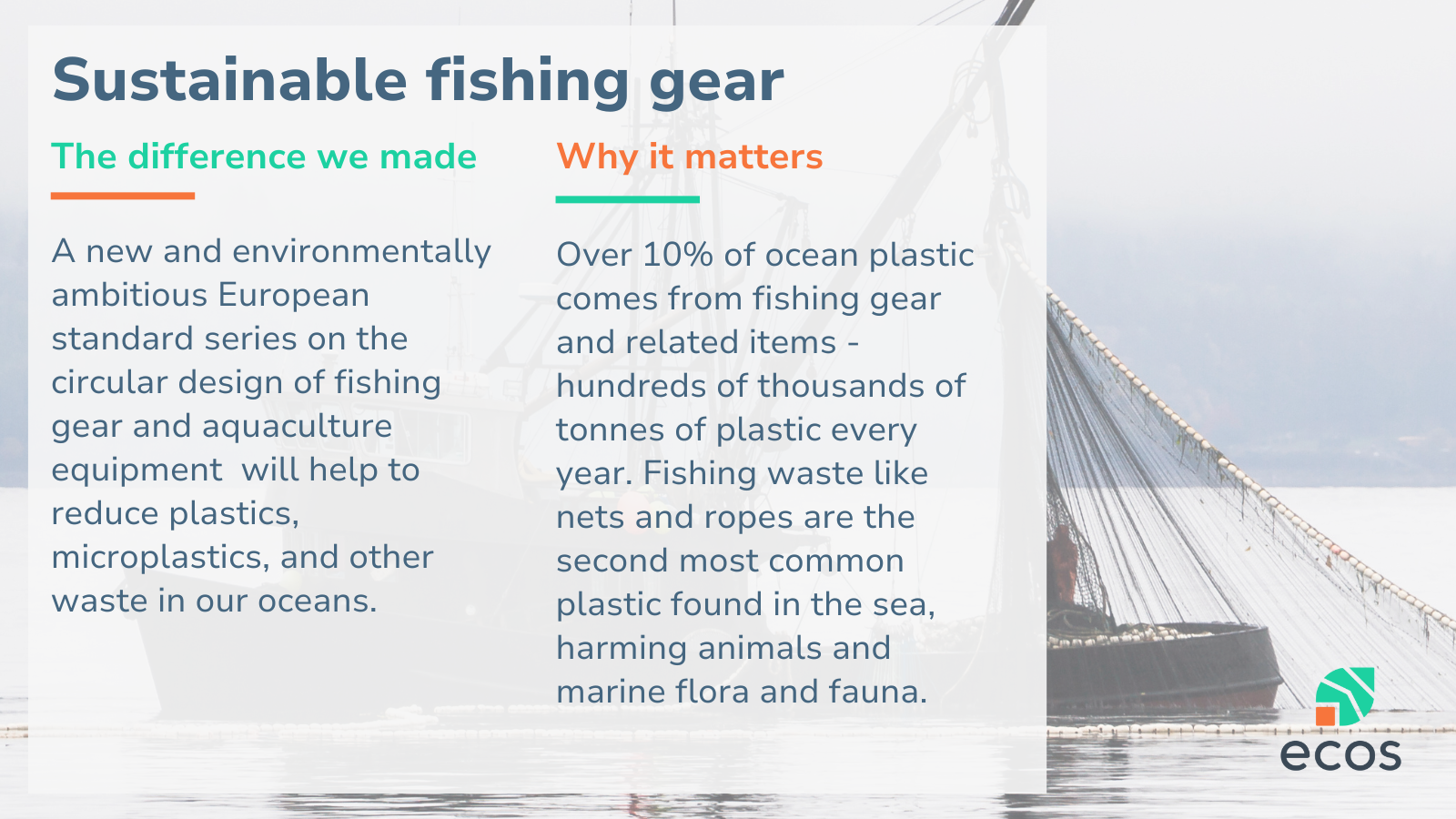Circular fishing gear: New standards to reduce plastic waste from fishing
After four years of hard work, a new European standard series on ‘Circular design of fishing gear and aquaculture equipment’ will help to reduce plastics, microplastics, and other waste in our oceans. The standards were requested in the Single Use Plastics Directive. These ambitious standards are the result of tireless work from ECOS and our experts, and are poised to make a real difference in the global fight against plastic pollution.

Over 10% of plastic in our oceans, or ‘marine plastic’, comes from fishing gear and other related items. This amounts to hundreds of thousands of tonnes of plastic every year. Fishing and aquaculture equipment, such as nets and ropes, are the second most common plastic items found in the sea. This waste harms fish, mammals, and birds in a number of ways, from entanglement, fatal ingestion, habitat damage, all the way to species loss. Due to the toxic nature of plastic and its resilience to degradation, plastics heavily impact marine fauna and flora over long periods. They also affect the productivity, safety, and profitability of fishing itself – the sector is considered particularly vulnerable to the impacts of plastic.
Developing a standard for the circular design of fishing gear
The fight against plastic pollution has been one of our priorities for years. This is why ECOS has been an active participant in the development of new European standards for the ‘Circular design of fishing gear and aquaculture equipment’ (EN 17988:2024 series) since its beginning. Published by the European standardiser CEN in November 2024, this series of standards originated from the EU Single Use Plastic Directive (‘SUPD’ 2019/904) and aims to address wide-ranging issues of fishing-related plastic waste.
Keen to ensure an ambitious implementation of the SUPD through robust standards, ECOS was involved in all stages of the drafting process, starting with important contributions to the Standardisation Request issued in 2020. We pushed for circular economy principles and best practices to be included throughout all six parts of the standard series, considering the waste hierarchy for decisions at different stages – repairability, modularity, reduction in materials, increased use of recycled materials, and much more feature in each of the six standards.
We also offered expertise and guidance, cross-referencing with other published standards and landmark EU legislation, such as the Ecodesign for Sustainable Products Regulation (ESPR). All through the process, we made amendments and recommendations that helped to keep the environmental ambition. These included, for example, ensuring that the standards do not promote false solutions, such as detrimental substitution with “biodegradable” products.
Overall, EN 17988 is an environmentally strong series of standards, which will support the circular design of fishing gear and can contribute to a meaningful reduction of marine plastics, especially when combined with a well-functioning Extended Producer Responsibility (EPR) scheme for fishing gear, which the Single-Use Plastics Directive mandates to be set up before the end of 2024. EPR is key – it aims to ensure that plastic fishing gear producers cover the costs of separate collection, transport and treatment of waste gear. We expect the new standards to support the development of EPR schemes, making a clear case for stewardship and accountability at all lifecycle phases.
In addition, the EN 17988 standard series could also play a role internationally – it is perfectly poised to offer measurable, actionable, and impactful change to the complex issues of plastic waste related to fishing and aquaculture, and support the UN Plastics Treaty – if and when the agreement is reached.
What is the EN 17988 standards series?
The series comprises six separate standards, all of which increase the circularity of fishing gear in all forms. Along with the CEN technical specification CEN/TS 18101:2024, which sets the relevant terms and definitions, they cover comprehensive aspects such as:
- Technical requirements on the material principles and processes that enhance the circularity and recycling of components and materials.
- Environmental and circularity requirements establishing sustainability principles that minimise the negative impact of plastic components.
- Digitalisation and information to align the digital transformation of the fishing and aquaculture sector with the general digital transition towards a circular economy, e.g. through marking, labelling and digital product passports.
- Circular business models.
The EN 17988 series will provide detailed and specific guidance for the fishing and aquaculture industry to transition away from a linear to a circular economy. ECOS will of course continue to be involved in future reviews to ensure it remains robust and supportive of sustainable design choices throughout fishing gear and aquaculture equipment life cycle. This will help reduce marine litter and the risks it poses to marine ecosystems, biodiversity and human health.


